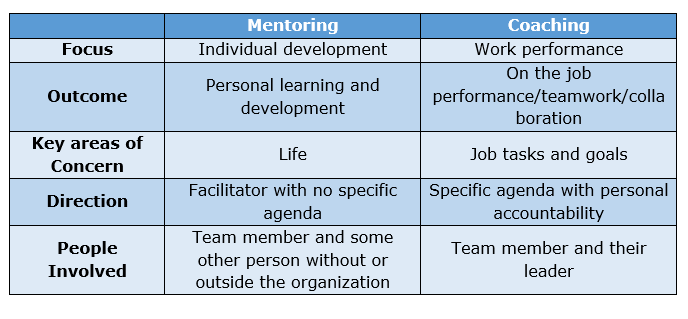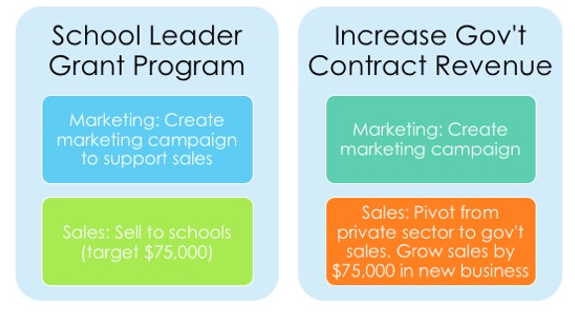Welcome to
Lead Motivate and Inspire your Dream TeamGuide a team the right way to achieve your business goals
Module Three
Coach Your Team to Maximum Success
So far, we’ve discussed ideas for how you can help your team members grow and contribute to your organization. In this chapter, we’ll look at a specific strategy for doing that: Coaching. By coaching your team members with goal-oriented behaviors, you will encourage them to do their best work while drastically reducing the amount of your own day-to-day involvement.
Coaching is the single most valuable team-building skill you can use as a leader not only to instill greater accountability among your team members, but also to gain greater insight into what’s working and not working with your team.
Coaching vs. Mentoring
Coaching and mentoring use some of the same skills and approaches, but there are major differences that need to be clarified. The main difference is that coaching is task or goal-based. It is directly related to work performance and whatever task is at-hand. Mentoring is a longer-term approach that is more focused on life and career goals.
The table below shows the key differences between coaching and mentoring:

One-on-One Coaching Sessions
Coaching successfully involves holding one-on-one touch points with your team members. With all that a small business or entrepreneur has to do, it’s easy to let these one-on-one sessions slide in favor of meetings or other pressing issues. But if you want to grow your business and give your team members the support they need, you need to meet them one on one.
These do not have to be formal coaching sessions. You just need to touch base with your team members for 20 to 30 minutes once every two weeks or so. During these informal meetings, review your team member’s short term goals and discuss progress against the goal or challenges the team member is facing.
If you have a large organization, it might be impossible to meet with so many team members once every two weeks. In this case, you should only focus on your core team, or those who are directly responsible to you. You can then set up protocols for managers in other divisions to hold similar coaching sessions with their team members.
If you have a large team that you need to meet with for coaching sessions, here are some ways to lighten the workload:
- Shorten session time from 20 to 15 or 10 minutes and make it more focused on one topic.
- Carry out basic coaching through email and meet only briefly when there are pressing issues that require discussion.
- Set aside a certain time when all team members report back to you; for example, choose a certain day each month for all coaching.
- Schedule coaching sessions less often; rather than once in two weeks, make it monthly.
- Use Skype, Google Hangouts, Zoom or another online communication method to reduce the time it takes to physically get together.
Tips on Running Your Coaching Sessions
- The team member should do most of the talking. Your job is to check in with them and see how you can help them achieve the goals you’ve jointly established. Listen to their progress and ask open-ended questions to help them solve the problem. Your main involvement should be to remove obstacles and offer your expertise when necessary.
- Keep the conversation positive. Use the tips discussed in the previous module to turn negatives into positives. Risks, threats, and failures should be seen as opportunities. Always add a bit of positive reinforcement to encourage your team member.
- Keep your meetings informal and encourage your team member to take notes. They can use a tool like One Note or Google Docs if they want to. You don’t need to see these notes. They are just for the team member’s reference in recalling what went on during the session. At each session, you can ask your team member to refer to their notes from the previous one. This helps them to see progress more easily.
Anatomy of a One-on-One Coaching Session
During your coaching session, you should be measuring the team member’s progress against two types of goals:
- Business goals
- Learning and development (L&D) goals or goals related to nurturing an innovation mindset (behaviors)
Business Goals
Business goals are those that are directly related to your core business intentions and objectives. You have overall goals for your business and you need to make sure that your team members’ individual goals support you in these. If you want to increase sales in the Midwest, for example, that should be the goal of your sales manager as well. Progress against these goals shows how well your team is contributing to your bottom line.
For example, say you have a leadership development agency that wants to increase sales in the business sector by 10% in the upcoming year. This is your business goal. Sales in the private sector are down 8%, so your goal is to target the public sector where there is potentially more growth. You could then be coaching a remote team in another state on how to take advantage of government initiatives there. They would then have a specific business goal related to public sector sales growth.
As another example, you might want to decrease your refund rate. If this is the case, you need to identify which members of your team can influence your refund rate, and then work with those team members, setting individual goals for them that are related.
Learning and Development Goals
Learning and development goals are broader, such as improving communication skills or sales skills. These may be group goals that trickle down to individual team members. For example, your whole sales staff might have a specific goal related to listening and asking good questions. You’ll work on this as a group, but each individual member should also have their own personal development goals.
Related to your business goal of increasing sales in the Midwest, you might have an L&D goal to improve content creation skills of individual staff members. Improving the quality of the content your team creates would then expand your content marketing, which would lead to better sales. A similar example would be teaching your sales staff how to effectively use a new social media platform.
For each individual coaching session, you then need to discuss progress and support needed for both that individual’s business goals and their learning and development goals. You’ll often find that there is quite a bit of overlap since a team member’s personal development will also affect their work performance.
As an example of this, one of your business goals might be to decrease refund rates. Every team member who answers customer support tickets will be involved in this effort. At the same time, they might be working on improving their communication skills. This goal can be applied directly to communicating with customers. Both the business goal of reducing refunds and the L&D goal of improving communication will have an impact on business overall. When a goal is tied to measurable results and your team members can see this, this will increase their motivation to implement what they learn.
There are two key stages to implementing your new coaching plan.
Stage 1: Preparing for Your Coaching Sessions by Setting Annual Goals
The first stage is to set annual goals. As a business owner, you should have 3-5 key things that you want to accomplish in a given year. Generally, these goals revolve around growing sales, improving efficiency or profitability, and keeping team members and customers happy.
An example of a business goal for company that sells leadership training might be to increase revenue by 10% through two new initiatives, a school leader grant training program, and increasing government sector contracts.
Once you’ve established annual business goals, you can break them down into milestones and specific actions which you can then work on with your team members in coaching sessions. This is often referred to as cascading goal setting because your goals “cascade” to your team members who then become accountable for specific actions toward them.
As an example, let’s take the goal mentioned above of increasing your revenue through a school leader grant training program.
The idea behind the program is to increase revenue for school leaders who can buy training by leveraging a new grant. This goal has an impact on two teams within your organization, sales and marketing. You would then work with the members of these teams to articulate goals for them that tie in to these bigger goals.
For sales, this might be something like selling this new training program to 10 schools or generating $75,000 in revenue.
For marketing, you might work with your team to create a smaller sub-goal for your team such as creating a marketing campaign to support the sales team.

Keep in mind that you’re not dictating to your team members. You present the problem and they come up with solutions. You could have them suggest what actions they think they could carry out to help your business reach its goals. The main purpose of establishing these goals is to drive accountability.
Be open and transparent about your goal setting. Your team members have ideally been involved along the way to provide input to help you grow your business. Your goal ideas don’t just come out of the clear blue sky. Once these goals are finalized, you can present your annual goals in a team meeting and let everyone know that you’ll be working with them 1:1 to determine their annual goals based on yours.
In addition to your business goals, you should also think about the types of learning and development goals you’re trying to accomplish. Identify behaviors that you chose to cultivate in Module 2. Get your team members to start thinking about things they need help with. Don’t suggest or force these goals on your team members. Rather, let them identify the areas in which they need help.
Stage 2: Rolling out Your 1:1 Coaching Sessions
Now that you have your annual goals and your teams know what they should be working toward over the course of the year, the next step is to set up your regular meetings. Earlier in the course, we suggested meeting bi-weekly. This is a good frequency to shoot for, but you can decide on your own based on what works best for you. Create a plan of what you intend to cover during your meetings. It should include:
- Business Goals
- L&D / Culture of Innovation Goals
Plan your agenda for your session in advance and share it with your team member before you meet. Give them a little time to prepare and be specific about what you want to discuss and how much time you’ll spend.
In addition, ask what your team member would like to discuss so that you can be better prepared to give support. Even if it’s just a 15-minute check-in, a little advance communication can keep the session tightly focused on walking away with concrete action steps.
Here’s a sample agenda of what your 1:1 coaching session might look like:
Part 1: Business Goals
- What progress was made since the last session?
- What are some specific numbers or results?
- What changes need to be made to the team member’s specific goals (if any)?
- What obstacles or challenges are slowing down or preventing progress?
Part 2: Learning & Development/Innovation Goals
- What progress was made since the last session?
- What have you learned and how are you applying that?
- What changes need to be made to the team member’s specific goals (if any)?
- Where do you need help or support?
Part 3: Moving Forward & Action Steps
- What will you do between now and the next coaching session?
- What do you need me (the coach) to do?
- Agree next steps and next meeting time.
Celebrating Successes
While you’re having your 1:1 meetings with team members, you also need to continue to have other team events where you’re sharing updates with the whole team. It is very important to formally recognize and celebrate everyone’s successes.
An example of an update might be something like: “We wanted to roll out a new school leader training program. We had targeted 40 schools, but Mary from marketing ended up getting us contact with 50 schools. Out of those 50, Mike from sales managed to get contracts with 24. This was a huge success for us. We had originally targeted only 10, so with 25, this has really blown away our expectations. Thanks so much for everyone’s help on this.”
Activity:
- What are your annual goals? Your goals should have components that each of your team members can contribute to in some way. Create 1-3 goals that you’ll be working on for the next year.
- Sharing your goals. Do you have regular meetings with all your team members? Are you sharing your goals? If not, schedule your next meeting and include a task for sharing your goals and the ‘why’ behind them.
- Coaching Agenda: Based on the ideas in this module create your own coaching session agenda template that you can implement, or modify the one provided in the Workbook. Your template should include space for each team member’s goals, which you’ll discuss in your session.
- Business goals
- L&D/ Innovation Goals
- For each of the people who report to you, create a bi-weekly 30 min calendar invite called ‘Coaching call’. Remember you’ll use the agenda you just created that focusses on Business goals and L&D/Innovation goals.
A Word
From Tamara
As an entrepreneur myself I completely understand the stress, anxiety and frustration around launching or growing a business. I also know the rewards and life style change the hard work can provide you if you stay focused. I am here to inspire and motivate you to push forward. The fact that you’re investing in your business education let’s me know you’re in this to win. Rest assured I’m here to help you…. These courses are set up to help you understand the basics. To dig deeper into your specific plan of action we will discuss where you are, where you want to be, eliminate any blocks preventing you from getting to the next step and create an action plan.

Our superpower is making you a superhero.

